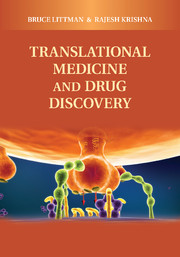Book contents
- Frontmatter
- Contents
- Contributors
- Preface
- Translational Medicine and Drug Discovery
- SECTION I TRANSLATIONAL MEDICINE: HISTORY, PRINCIPLES, AND APPLICATION IN DRUG DEVELOPMENT
- 1 TRANSLATIONAL MEDICINE: DEFINITION, HISTORY, AND STRATEGIES
- 2 TRANSLATIONAL MEDICINE AND ITS IMPACT ON DIABETES DRUG DEVELOPMENT
- 3 CHALLENGES IN ATHEROSCLEROSIS
- 4 OBESITY: NEW MECHANISMS AND TRANSLATIONAL PARADIGMS
- 5 BONE DISORDERS: TRANSLATIONAL MEDICINE CASE STUDIES
- 6 CASE STUDIES IN NEUROSCIENCE: UNIQUE CHALLENGES AND EXAMPLES
- 7 TRANSLATIONAL MEDICINE IN ONCOLOGY
- SECTION II BIOMARKERS AND PUBLIC–PRIVATE PARTNERSHIPS
- SECTION III FUTURE DIRECTIONS
- Index
- References
1 - TRANSLATIONAL MEDICINE: DEFINITION, HISTORY, AND STRATEGIES
Published online by Cambridge University Press: 04 April 2011
- Frontmatter
- Contents
- Contributors
- Preface
- Translational Medicine and Drug Discovery
- SECTION I TRANSLATIONAL MEDICINE: HISTORY, PRINCIPLES, AND APPLICATION IN DRUG DEVELOPMENT
- 1 TRANSLATIONAL MEDICINE: DEFINITION, HISTORY, AND STRATEGIES
- 2 TRANSLATIONAL MEDICINE AND ITS IMPACT ON DIABETES DRUG DEVELOPMENT
- 3 CHALLENGES IN ATHEROSCLEROSIS
- 4 OBESITY: NEW MECHANISMS AND TRANSLATIONAL PARADIGMS
- 5 BONE DISORDERS: TRANSLATIONAL MEDICINE CASE STUDIES
- 6 CASE STUDIES IN NEUROSCIENCE: UNIQUE CHALLENGES AND EXAMPLES
- 7 TRANSLATIONAL MEDICINE IN ONCOLOGY
- SECTION II BIOMARKERS AND PUBLIC–PRIVATE PARTNERSHIPS
- SECTION III FUTURE DIRECTIONS
- Index
- References
Summary
What is translational medicine? This discipline, although defined differently by various groups in academia, regulatory institutions, and industry, shares the fundamental vision of translational medicine, which is to efficiently and effectively translate basic scientific findings relevant to human disease into knowledge that benefits patients. Pfizer was one of the first pharmaceutical companies to embrace experimental medicine and translational medicine as a recognized discipline within the sphere of early drug development, and this author was intimately involved in the evolution of this discipline since its inception at this company. This chapter therefore describes the significance, role, and practice of translational medicine in drug development from a Pfizer perspective, although the concepts are considered to be widely applicable to drug development at any academic, public, or private institution. At Pfizer, translational medicine was defined as “the integrated application of innovative pharmacology tools, biomarkers, clinical methods, clinical technologies, and study designs to improve confidence in human drug targets and increase confidence in drug candidates, understand the therapeutic index in humans, enhance cost-effective decision making in exploratory development, and increase success in Phase 2 leading to a sustainable pipeline of new products.” Because this book focuses on drug development, this will be the definition for the purposes of this chapter.
In the late 1980s and early 1990s, pharmaceutical companies were rapidly adopting a drug discovery strategy that depended on selecting drug targets based on what was known about key pathways important in disease expression, enzymes that catalyzed rate-limiting steps along the pathway, or cellular receptors that were ligated by important relevant mediators.
- Type
- Chapter
- Information
- Translational Medicine and Drug Discovery , pp. 3 - 34Publisher: Cambridge University PressPrint publication year: 2011
References
- 1
- Cited by



